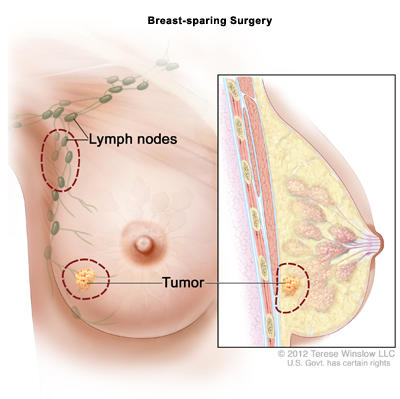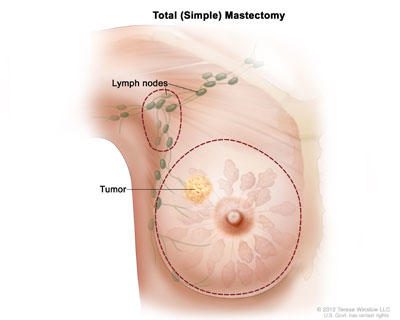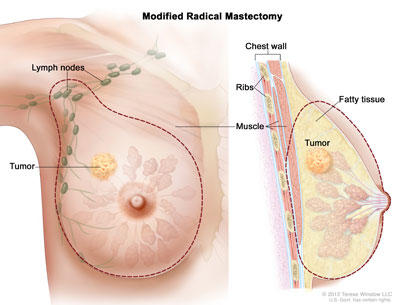Surgery Choices for DCIS or Breast Cancer (original) (raw)
Are you facing a decision about surgery for DCIS or breast cancer?
Do you have ductal carcinoma in situ (DCIS) or breast cancer that can be removed with surgery? If so, you may be able to choose which type of breast surgery to have. Often, your choice is between a lumpectomy or other breast-sparing surgery (surgery that takes out the cancer and leaves most of the breast) and a mastectomy (surgery that removes the whole breast).
Once you are diagnosed, treatment will usually not begin right away. Use the time to
- talk with your doctor
- get a second opinion
- check with your insurance company
- learn the facts about your surgery choices
- think about what is important to you

Surgery Choices: Theresa
Breast cancer is scary, but it can be successfully treated.
Learn about the types of breast surgery
Most women with DCIS or breast cancer that can be treated with surgery have three surgery choices.
- lumpectomy or other breast-sparing surgery, such as
- mastectomy
- mastectomy with reconstruction
Lumpectomy or other breast-sparing surgery, followed by radiation therapy
Breast-sparing surgery means the surgeon removes only the DCIS or cancer, some normal tissue around it, and maybe one or more lymph nodes from under your arm. Breast-sparing surgery usually allows your breast to look much like it did before surgery.
After breast-sparing surgery, you might also receive radiation therapy. The main goal of this treatment is to keep cancer from coming back in the same breast. Some people will also need chemotherapy, hormone therapy, or targeted therapy.

Credit: © Terese Winslow
Mastectomy
In a mastectomy, the surgeon removes the whole breast that contains the DCIS or cancer. There are two main types of mastectomy.
- Total mastectomy. Also called simple mastectomy. In this type of surgery, the surgeon removes your whole breast. Sometimes, they also remove one or more of the lymph nodes under your arm using a procedure called sentinel lymph node biopsy.

Credit: © Terese Winslow
- Modified radical mastectomy. The surgeon removes your whole breast and most of the lymph nodes under your arm. This surgery is rarely used for DCIS.

Credit: © Terese Winslow
If you have a mastectomy, you might also need radiation therapy, chemotherapy, hormone therapy, or targeted therapy.
After a mastectomy, you may choose to stay flat, wear a prosthesis (breast-like form) in your bra, or have breast reconstruction surgery.
Mastectomy with breast reconstruction surgery
You can have breast reconstruction at the same time as the mastectomy, or anytime afterward. This type of surgery is done by a plastic surgeon with experience in breast reconstruction surgery. The surgeon uses an implant or tissue from another part of your body to create a breast-like shape that replaces the breast that was removed. If your nipple is removed, the surgeon may also make the form of a nipple and add a tattoo that looks like the areola (the dark area around your nipple).
There are two main types of breast reconstruction surgery, breast implant and tissue flap. See Breast Reconstruction after Mastectomy for more information.

Surgery Choices: Cindy, Theresa, Paula
Three women describe the type of surgery that they chose to treat their breast cancer.
Compare the types of breast surgery
If your surgeon gives you a choice about which surgery to have, it can be hard to decide which one is best for you. This section can help you compare the different surgeries with each other. See how the surgeries are alike and how they are different by clicking on each question to learn more.
- Which type of breast cancer surgery is best for my cancer?
- Will the type of surgery I have affect how long I live?
- What are the chances that my breast cancer will return in the same area?
- Will I have pain?
- How long before I can return to normal activities?
- What other problems might I have from the surgery?
- What other types of treatment might I need?
- Will I need more surgery?
- What will my breast look like after surgery?
- Will my breast have feeling after surgery?
- Will the type of surgery I choose affect my quality of life?
Questions about the effectiveness of breast cancer surgery
Which type of breast cancer surgery is best for my cancer?
| Lumpectomy or other breast-sparing surgery | Most women with DCIS or breast cancer can choose to have breast-sparing surgery, usually followed by radiation therapy. |
|---|---|
| Mastectomy | Most women with DCIS or breast cancer can choose to have a mastectomy. A mastectomy may be a better choice for you if You have small breasts and a large area of DCIS or cancer. You have DCIS or cancer in more than one part of your breast. The DCIS or cancer is under the nipple. You are not able to receive radiation therapy. |
| Mastectomy with reconstruction | If you have a mastectomy, you might also want breast reconstruction surgery. You can choose to have reconstruction surgery at the same time as your mastectomy or wait and have it later. Your surgeon can talk with you about how much skin, including the nipple and areola, might be preserved for reconstruction. |
Will the type of breast cancer surgery I have affect how long I live?
No. Research shows that women who have breast-sparing surgery live as long as women who have a mastectomy. This does not change if you also have reconstruction.
What are the chances that my breast cancer will return in the same area?
| Lumpectomy or other breast-sparing surgery | There is a chance that your cancer will come back in the same breast. But if it does, it is not likely to affect how long you live. About 5% to 10% of women (1 out of every 10 to 20) who have breast-sparing surgery along with radiation therapy get cancer in the same breast within 12 years. If this happens, you can be effectively treated with a mastectomy. |
|---|---|
| Mastectomy | There is a chance that your cancer will return in the same area where the breast was removed. But it is slightly less than if you have breast-sparing surgery. About 5% of women (1 out of every 20) who have a mastectomy will get cancer on the same side of their chest within 12 years. |
| Mastectomy with reconstruction | Your chances are the same as mastectomy since breast reconstruction surgery does not affect the chances of the cancer returning. |
Questions about recovering from breast cancer surgery
Will I have pain?
Most people have some pain after surgery.
Talk with your doctor or nurse before surgery about ways to control pain after surgery. Also, tell them if your pain control is not working.
How long before I can return to normal activities?
| Lumpectomy or other breast-sparing surgery | Most women are ready to return to most of their usual activities within 5 to 10 days. |
|---|---|
| Mastectomy | It may take 3 to 4 weeks to feel mostly normal after a mastectomy. |
| Mastectomy with reconstruction | Your recovery will depend on the type of reconstruction you have. It can take 6 to 8 weeks or longer to fully recover from breast reconstruction. |
What other problems might I have from breast cancer surgery?
| Lumpectomy or other breast-sparing surgery | You may feel very tired and have skin changes from radiation therapy. |
|---|---|
| Mastectomy | You may feel out of balance if you had large breasts and do not have reconstruction surgery. This may also lead to neck and shoulder pain. |
| Mastectomy with reconstruction | You may not like how your breast-like shape looks. If you have an implant your breast may harden and can become painful. If your implant breaks or leaks you may need more surgery. If you have flap surgery, you may lose strength in the part of your body where a muscle was removed. |
If lymph nodes are removed from under your arm, you may develop lymphedema. See Lymphedema and Cancer Treatment to learn more.
Questions about treatment after breast surgery
What other types of treatment might I need after breast cancer surgery?
If you choose to have a lumpectomy or other breast-sparing surgery, you will usually need radiation therapy. Radiation treatments are often given 5 days a week for 1 to 6 weeks.
If you have a mastectomy, you may still need radiation therapy.
No matter which surgery you choose, you might need
- chemotherapy
- hormone therapy
- targeted therapy
To learn more about other cancer treatments, see
- Radiation Therapy to Treat Cancer
- Chemotherapy to Treat Cancer
- Hormone Therapy to Treat Cancer
- Targeted Therapy to Treat Cancer
Will I need more surgery?
| Lumpectomy or other breast-sparing surgery | After surgery, if there are cancer cells at the edge of the removed breast tissue, then you may need more surgery to make sure that all of the cancer is removed. |
|---|---|
| Mastectomy | If you have problems after your mastectomy, you may need more surgery. |
| Mastectomy with reconstruction | You will most likely need more than one surgery to build a new breast-like shape. The number of surgeries you need will depend on the type of reconstruction you have and if you choose to have a nipple or areola added. Some women may also decide to have surgery on the opposite breast to help it better match the reconstructed breast. If you have an implant, you are likely to need surgery many years later to remove or replace it. |
With all three surgeries, you may need more surgery to remove lymph nodes from under your arm. Having lymph nodes removed can cause lymphedema.
Questions about body image and quality of life after breast cancer surgery
What will my breast look like after breast cancer surgery?
| Lumpectomy or other breast-sparing surgery | Your breast should look a lot like it did before surgery. But if your tumor is large, your breast may look different or smaller after breast-sparing surgery. You will have a small scar where the surgeon cut to remove the DCIS or cancer. The length of the scar will depend on how large an incision the surgeon needs to make. |
|---|---|
| Mastectomy | Your breast and nipple will be removed. You will have a flat chest on the side of your body where the breast was removed. You will have a scar over the place where your breast was removed. The length of the scar will depend on the size of your breast. The scar is usually shorter for smaller breasts and longer for larger breasts. |
| Mastectomy with reconstruction | Your breast will not look or feel like it did before surgery. And, it will not look or feel like your other breast. You will have scars where the surgeon stitched skin together to make the new breast-like shape. If you have tissue flap reconstruction, you will have scars around the new breast, as well as the area where the surgeon removed the muscle, fat, and skin to make the new breast-like shape. |
To get a better idea of what to expect from surgery, ask your surgeon if you can see before and after pictures of other people who have had different types of surgery.
The scars left from where the surgeon cut the skin and stitched it back together tend to fade over time.
Will my breast have feeling after breast cancer surgery?
| Lumpectomy or other breast-sparing surgery | Yes. You should still have feeling in your breast, nipple, and areola (the dark area around your nipple). |
|---|---|
| Mastectomy | Maybe. After surgery, the skin around where the surgeon cut and maybe the area under your arm will be numb (have no feeling). This numb feeling may improve over 1 to 2 years, but it will never feel like it once did. Also, the skin where your breast was may feel tight. |
| Mastectomy with reconstruction | No. Most of the area around your breast will not have feeling. |
Will the type of breast surgery I choose affect my quality of life?
Research suggests that women who have breast-sparing surgery have a better long-term quality of life than those who have a mastectomy. To learn more, see Breast Cancer Surgery Choice May Affect Young Survivors' Quality of Life.
Think about what is important to you
After you have talked with a breast cancer surgeon and learned the facts, you may also want to talk with your spouse or partner, family, friends, or other women who have had breast cancer surgery.

Surgery Choices: Theresa, Cindy, Paula
Three women describe how they decided which type of breast cancer surgery was right for them.
Then, think about what is important to you. Thinking about these questions and talking them over with others might help:
Questions to ask about breast surgery choices
- If I have a lumpectomy or other breast-sparing surgery, am I willing and able to have radiation therapy 5 days a week for 1 to 6 weeks?
- If I have a mastectomy, do I also want breast reconstruction surgery?
- If I have breast reconstruction surgery, do I want it at the same time as the mastectomy?
- What treatment does my insurance cover? What do I have to pay for?
- How important is it to me how my breast looks after cancer surgery?
- How important is it to me how my breast feels after cancer surgery?
- If I have a mastectomy and do not have reconstruction, will my insurance cover prostheses and special bras?
- Where can I find breast prostheses and special bras?
Learning more about my breast cancer surgery choices
- Do I want a second opinion?
- Is there someone else I should talk with about my surgery choices?
- What else do I want to learn or do before I decide about breast cancer surgery?